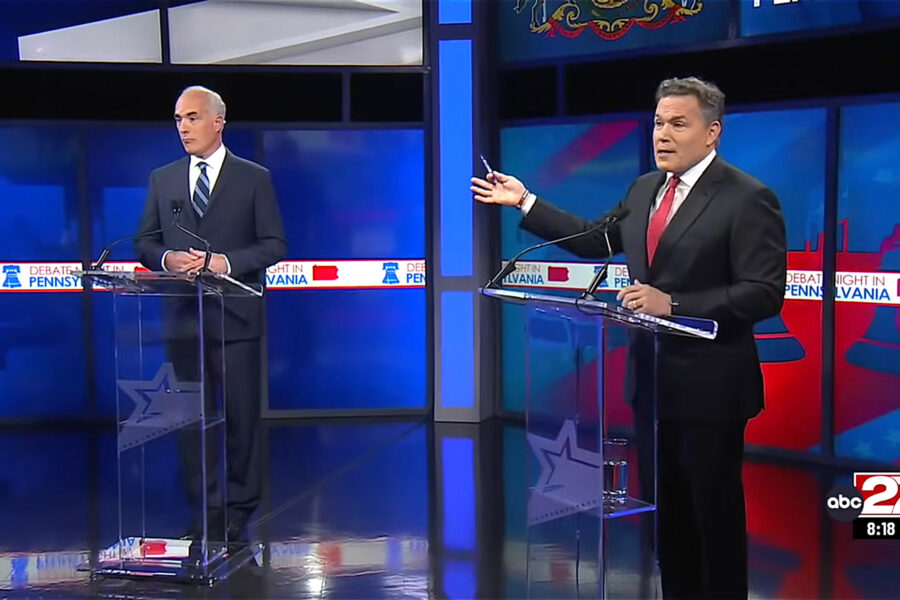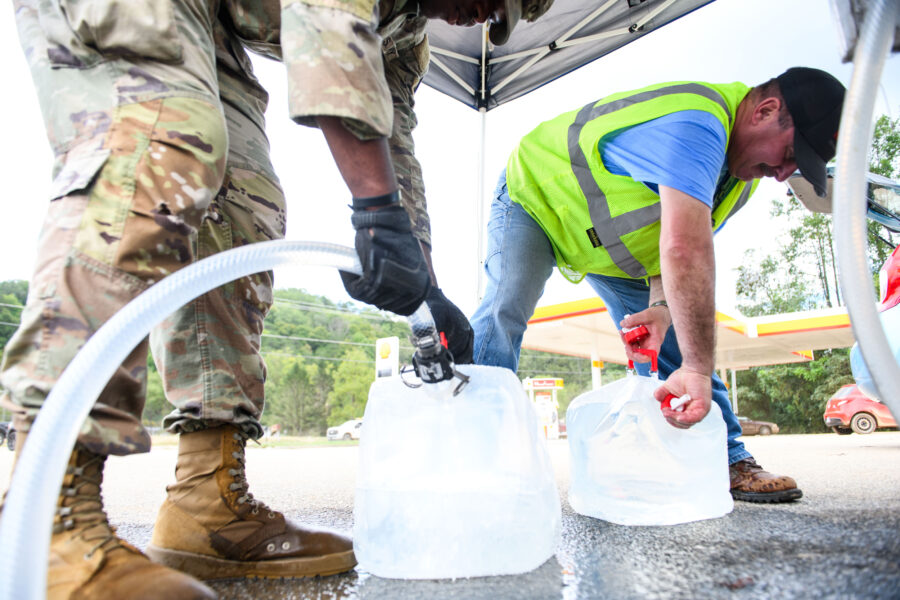Why Isn’t the IRA More of a Political Winner for Democrats?
The Inflation Reduction Act is delivering jobs and investment to communities around the country, but the elected officials who supported the law are getting little political benefit.
I saw this when working on my story about the U.S. Senate race in Ohio between Democrat Sherrod Brown, the incumbent, and Republican Bernie Moreno. But the dynamic is not limited to Ohio—reporting from other races shows negligible political gains for candidates who supported the IRA, as in Nevada.
In places that stand to benefit from the IRA, such as Jeffersonville, Ohio, there is an almost complete lack of awareness or acknowledgement of the role of federal policy. The rural village is about to be transformed by the opening of a $3.5 billion battery manufacturing plant operated by Honda and LG, which brings with it a projected 2,200 jobs.
This lack of awareness is multifactorial, as a doctor might say, and I want to dig into what’s going on and what we should make of it.
Some possible explanations for why Brown isn’t getting credit for what’s happening in Jeffersonville:
- Honda was in discussions about opening a battery plant before the IRA became law, even though the specific site was announced two months after the signing. State and local officials also played roles in attracting Honda to Jeffersonville. These factors diminish the ability of federal officials to claim full credit.
- While local officials welcome the investment, electric vehicles and their batteries are politically fraught, with some Republicans claiming federal policies supported by Democrats would almost immediately push gasoline vehicles out of the market and take away options from consumers.
- Ohio voters care about the economy, but in the context of the Senate race this concern is about immediate economic insecurity related to high costs of food and housing.
- The plant won’t begin production until next year, so many of the economic benefits haven’t yet been realized.
The IRA passed the Senate in 2022 by one vote, with support from every Democrat, including Brown, and opposition from every Republican. Among its many components, the law provides tax credits for investments to build factories that make renewable energy or electric vehicle components.
The Jeffersonville plant will receive a credit based on its level of production at $10 per kilowatt-hour of storage capacity. Honda has said the plant will have a maximum annual capacity of 40 gigawatt-hours of batteries, which would lead to a credit of $400 million per year that would continue until the credit phaseout begins in 2030. (Thanks to RMI, the research and advocacy group, for helping me to explain this.)
The plant is one of many manufacturing projects in Ohio that stand to receive aid from the IRA. Others include Illuminate USA, a solar panel manufacturer in Pataskala with about 1,000 employees, and Schaeffler, a vehicle parts manufacturer in Dover with about 650 employees.
In all, companies have announced 18 IRA-linked projects in Ohio, with $7.1 billion in private spending and 4,854 jobs, according to a database compiled by E2, a trade group. (The Honda-LG plant is the big one, with more than half the dollars and nearly half the jobs.)
The best may be yet to come. RMI used its Clean Growth Tool to give me estimates of which counties have the greatest potential to benefit from clean technology investment under the IRA. Cuyahoga County, which includes Cleveland, ranks in the top 1 percent of counties that could profit from the policy nationwide, and another 14 Ohio counties are in the top 5 percent.
“The cleantech factory boom in Ohio may just be getting started,” said Aaron Brickman, RMI’s senior principal for economic development, in an email.
But that doesn’t do much to help elect or reelect the people who supported the IRA and are likely to oppose any attempts to claw back funding or cut the law’s programs.
To better understand the intersection of the IRA and electoral politics, I reached out to Sam Ricketts, co-founder of S2 Strategies, a clean energy consulting firm. He was a longtime adviser to former Washington Gov. Jay Inslee and co-founded Evergreen Action, an advocacy group that worked to pass the IRA.
“The results are very clear,” he said. “Just the plain old numbers and projects have been utterly transformative.”
But the results are not receiving much attention because of a combination of media outlets not reporting enough about them and political candidates not talking enough about them, he said.
Ricketts’ media criticism is mostly directed at partisan outlets that aren’t eager to cover things that might reflect positively on Democrats. The challenge of explaining legislative accomplishments is a familiar one for Democrats, he said.
“Democrats, for good or ill, sometimes focus on the next challenges and don’t spend enough time celebrating the progress,” he said. “We’ve made enormous progress.”
The IRA is the largest climate and carbon-free energy law in the history of the world. Even if media outlets and candidates talk little about it, this doesn’t diminish its importance.
And, even if Sherrod Brown gets little political benefit from his vote for the IRA, that vote still mattered a lot.
***
Other stories about the energy transition to take note of this week:
A Tiny Town Slammed by Helene Could Massively Disrupt the Solar Industry: Hurricane Helene has stopped production at North Carolina factories that are some of the only sources of high-purity quartz used to make computer chips and solar panels, as Geoff Brumfiel, Scott Neuman and Camila Domonoske report for NPR. The factories are in Spruce Pine, N.C., where heavy rainfall has led to power outages and flooding. Spruce Pine isn’t the world’s only source of high-purity quartz, but it is the largest and is known for having the highest quality, according to an expert NPR reporters interviewed.
U.S. Approves Aid to Restart Michigan Nuclear Plant: The federal government has finalized a $1.52 billion loan guarantee to help Holtec International reopen the Palisades nuclear plant in Michigan, as Brad Plumer reports for the New York Times. Two rural electricity providers that plan to buy electricity from the reactor would also receive $1.3 billion in federal grants. The 800-megawatt Palisades plant shut down in 2022 and it would be the first nuclear facility in the country to close and then reopen.
Ford Targets EV ‘Fence-Sitters’ with Offer of Free Home Charger and Installation: Ford has launched a new initiative to cover the costs of putting EV charging systems in customers’ homes, as Andrew J. Hawkins reports for The Verge. The automaker is offering a $1,310 charger plus the costs of installation. Customers would need to cover the costs of upgrading their electrical panel, if that’s needed. Ford’s program is part of a larger strategy to overcome obstacles that may be stopping customers from buying or leasing an EV.
BOEM Postpones First Oregon Offshore Wind Auction Due to Lack of Interest: The Bureau of Ocean Energy Management has postponed an auction of two wind energy leases off of Oregon due to lack of interest from bidders, as Diana DiGangi reports for Utility Dive. The bureau listed five eligible bidders, but only one was interested in making a bid. The auction would have been the first of its kind off the coast of Oregon. This is the second time the bureau canceled an auction due to lack of interest, following similar actions this summer with Gulf of Mexico leases. There are several possible reasons that bidders are skittish, including the effects of high interest rates and concerns about the risks of building projects in regions that don’t already have offshore wind.
How the UK Became the First G7 Country to Phase Out Coal Power: The United Kingdom’s last coal-fired power plant, Ratcliffe-on-Soar in Nottinghamshire, has closed, ending a 142-year era of coal-fired electricity in the country. Molly Lempriere and Simon Evans report for CarbonBrief on the history of coal power and the factors that contributed to the phaseout.
Inside Clean Energy is ICN’s weekly bulletin of news and analysis about the energy transition. Send news tips and questions to [email protected].
About This Story
Perhaps you noticed: This story, like all the news we publish, is free to read. That’s because Inside Climate News is a 501c3 nonprofit organization. We do not charge a subscription fee, lock our news behind a paywall, or clutter our website with ads. We make our news on climate and the environment freely available to you and anyone who wants it.
That’s not all. We also share our news for free with scores of other media organizations around the country. Many of them can’t afford to do environmental journalism of their own. We’ve built bureaus from coast to coast to report local stories, collaborate with local newsrooms and co-publish articles so that this vital work is shared as widely as possible.
Two of us launched ICN in 2007. Six years later we earned a Pulitzer Prize for National Reporting, and now we run the oldest and largest dedicated climate newsroom in the nation. We tell the story in all its complexity. We hold polluters accountable. We expose environmental injustice. We debunk misinformation. We scrutinize solutions and inspire action.
Donations from readers like you fund every aspect of what we do. If you don’t already, will you support our ongoing work, our reporting on the biggest crisis facing our planet, and help us reach even more readers in more places?
Please take a moment to make a tax-deductible donation. Every one of them makes a difference.
Thank you,
David Sassoon
Founder and Publisher
Vernon Loeb
Executive Editor
Share this article
- Republish
Disclaimer: The copyright of this article belongs to the original author. Reposting this article is solely for the purpose of information dissemination and does not constitute any investment advice. If there is any infringement, please contact us immediately. We will make corrections or deletions as necessary. Thank you.







